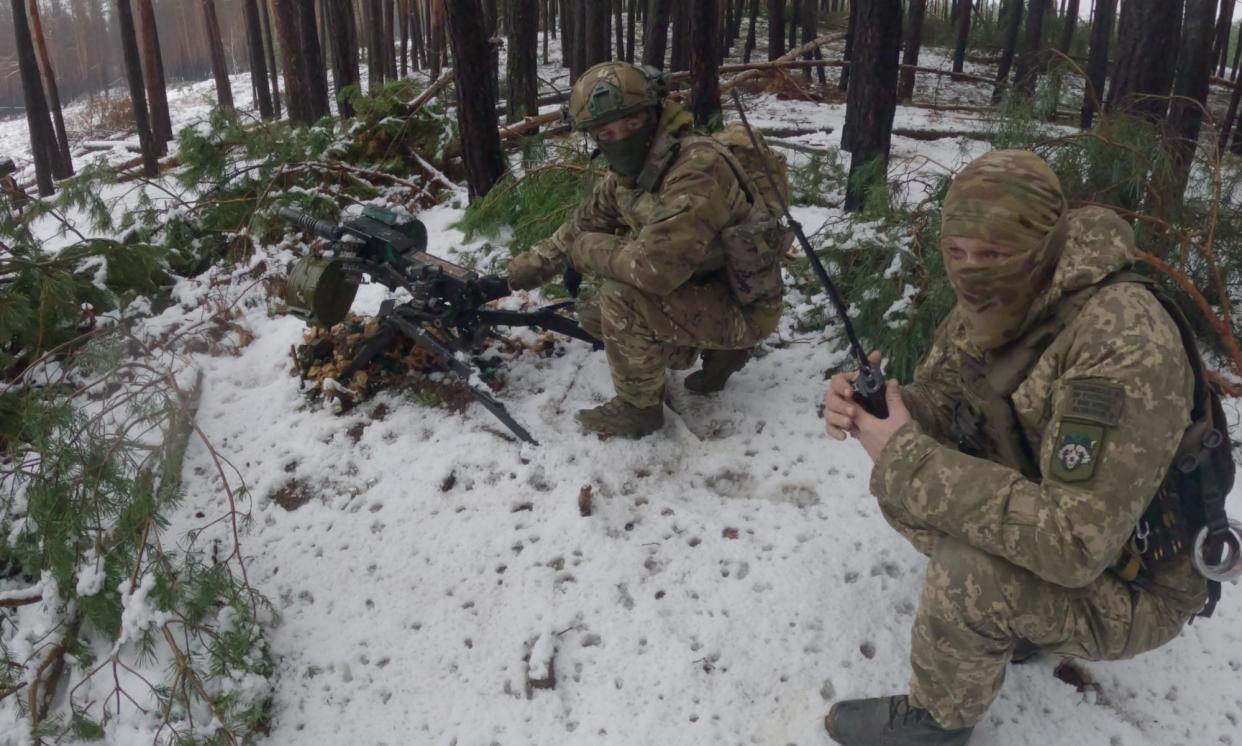‘I’ve never seen war shown like this’: film-maker captures Ukraine conflict from soldiers’ view

For all the coverage of war in Ukraine, it is rare to see it from the point of view of soldiers on the front. But by asking Ukrainians to wear cameras on their helmets as they face down relentless Russian attacks, Jamie Roberts’s BBC Two documentary has captured the bloody reality of a conflict increasingly forgotten in the west.
The director says the intimate and harrowing film, Ukraine, Enemy in the Woods, was conceived as a response to war fatigue. But, if anything, the grim and often unheroic struggle in the frozen forest north-west of Kupyansk emphasises the sheer level of human loss that Ukraine is suffering in defence of its homeland.
Roberts spent seven weeks with the Berlingo company in November and December last year to make the film, which will be broadcast on Monday night. During that time the 99-strong force lost 10 people, with another 66 wounded so seriously they could no longer fight – a casualty rate of 76%.
“You can go online and see reams of graphic violence on social media like Telegram, but it all has zero context. Our aim was to show a true picture of what is happening, showing the humanity, the relationships of the soldiers. I have never seen war shown like this; when you see it on the news, it often seems under control,” Roberts said.
It took several weeks for Roberts to find the Berlingo company. Although several Ukrainian units were willing to work with the BBC film-maker, by the time he got out to meet them in the field “often they had been decimated, wrecked” by having taken too many casualties. Large units were often reduced to 15% of full strength.
An unforgettable sequence towards the end of the documentary is taken from the point of view of Vovan, a company commander, his shortened breathing a constant accompaniment to the battle scenes that follow. The film has no narration, so the action and accompanying interviews bear the weight of the story.
Contact with the next foxhole has been lost – a lot of the time, Roberts said, the soldiers are simply trying to find out what is happening. Vovan heads out looking for his buddies, call signs Fury and Adidas. First he finds several dead Russians, evidence of a firefight, then a nervy search of the foxhole reveals his dead comrades.
Vovan helps in putting their bodies on to stretchers, but there is further gunfire and evidence, presumably from a drone, that there is at least one living Russian soldier nearby. The Ukrainian stalks towards a depression in the ground, where there is some movement ahead, and he twice unloads his clip, killing him.
It is a carefully edited scene, not gory despite what is depicted, and it captures the reality of the combat: isolated, fragmentary and grim. Roberts justifies showing it, arguing “we martialled it carefully. This is not graphic violence for graphic violence’s sake. This is not a war of stalemate; huge numbers of people are being killed daily”.
Vovan reflects on the episode in the documentary and hints these encounters will remain with him a long time: “We killed a lot of people. [But] it was all negative because we lost our brothers in arms. It was very, how can I put it, very nerve-shredding. My head was full of everything and I needed to unload it.”
An obvious conclusion to draw is that fighting in the remote landscape is pointless. But despite the casualties they are taking, the Ukrainians filmed talk of the necessity of holding back the Russians, their hopes for a democratic future, and in the words of a combat medic, Natalia, the only woman filmed, of finding a home after the war to renovate and to “adopt more dogs, lots of dogs”.
The documentary makes clear that the Russian invaders are taking far greater numbers of casualties in the battle for the forest, “between three and 10 to one”, Roberts estimated. Often they are poorly trained, unwisely massing in large groups, but while a couple are shown captured, very few surrender.
Even so, for the Ukrainian defenders there is very little respite, and their supplies of weaponry are increasingly short, in a conflict that appears without end. This is not a film that could or would have been made in the first 18 months of the war, Roberts says. Having spent seven weeks working daily a few miles from the frontline, he now believes President Volodymyr Zelenskiy’s recent statement that 31,000 Ukrainians had been killed in the war is almost certainly an underestimate.
• Ukraine, Enemy in the Woods is available to watch on iPlayer and will be broadcast on BBC Two at 9pm on Monday 25 March


